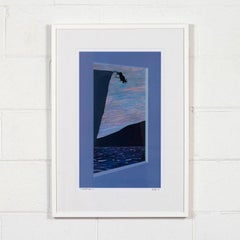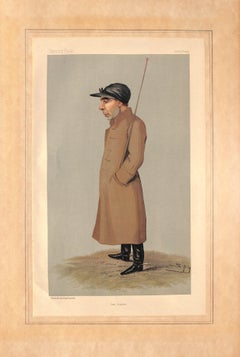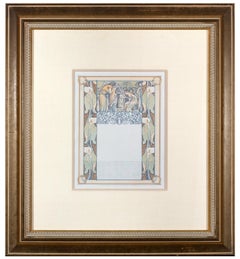Late 19th Century Figurative Prints
to
114
1,802
388
106
24
30
Overall Width
to
Overall Height
to
1,457
79
44
27
25
6
5
1
1
75
47
38
37
33
3,533
7,595
25,374
6,826
293
597
1,413
1,242
1,342
2,301
3,259
5,170
2,833
1,318
3,030
1,637
704
7
1,357
759
546
500
452
364
362
352
339
177
159
145
143
114
103
94
93
88
88
64
1,174
653
412
198
107
157
1,522
1,267
428
Period: Late 19th Century
Charles Pachter "Moose Plunge"
Located in Toronto, Ontario
Charles Pachter is one of the most collected and cherished Canadian artists.
His iconic, uplifting and patriotic images have independently earned their place in the nation's museum...
Category
Contemporary Late 19th Century Figurative Prints
Materials
Lithograph
Sam Loates Spy Vanity Fair Nov 5th 1896
Located in Bristol, CT
1896
Print Sz: 14 1/2"H x 9"W
Mat Sz: 20"H x 12 7/8"W
Samuel Loates (1865–1932) was a British Thoroughbred horse racing jockey who was the Champion Jockey of 1899 in his home coun...
Category
Late 19th Century Figurative Prints
Materials
Lithograph
James Woodburn Spy Vanity Fair June 21 1890
Located in Bristol, CT
1890
Sz: 20"H x 12 7/8"W
James Woodburn
1863-1919
Born at York on September 20, 1863, James began life as a doctor’s errand boy but, wanting to become a jockey, he ran away from home. Covering the 13 miles on foot, he arrived at the Hambleton stables of Mr Sanderson, who took an instant liking to the runaway. Woodburn rode his first winner for the stable...
Category
Late 19th Century Figurative Prints
Materials
Lithograph
From Ilsee, Princess of Tripoli Recto: "Visiting Women" Verso: "Departing Pilgri
Located in Milwaukee, WI
"From Ilsee, Princess of Tripoli Recto: "Visiting Women" Verso: "Departing Pilgrims" is an original color lithograph by Alphonse Mucha. Exquisite double-sided color lithographs from...
Category
Art Nouveau Late 19th Century Figurative Prints
Materials
Lithograph
THE BOOKMAN CHRISTMAS NUMBER. Circa 1895.
Located in New York, NY
LOUIS J. RHEAD (1858-1926) THE BOOKMAN / CHRISTMAS NUMBER. Circa 1895.
19x11 1/2 inches, Dodd, Mead & Company, New York. Color Lithograph. Good condition.
No rips or tears or folds. Good color. Framed. Ref: Das Plakat...
Category
Art Nouveau Late 19th Century Figurative Prints
Materials
Lithograph
La Rentree au Seminaire
Located in New York, NY
Jean-Emile Laboureur (1877-1943), La Rentree au Seminaire, 1897, woodcut, signed in ink lower right and inscribed “tire a 15 ex.” [also with monogram in the plate]. Reference: Laboureur 566, only state. In good condition, with some staining toward margin edge not affecting image, tack-holes at corners, 4 3/8 x 4 3/8, the sheet 9 5/8 x 8 1/2 inches.
A fine impression, printed on a grey/green wove paper.
A very early woodcut; the first time that Laboureur used a monogram within the plate.
This woodcut was made shortly after Laboureur learned printmaking from the famed printmaker – and woodcut specialist – Auguste Lepere; and the composition, with its ordering of a mass of marchers, appears to be influenced by Felix Valloton...
Category
Abstract Geometric Late 19th Century Figurative Prints
Materials
Woodcut
Sortie De Bal - After The Ball
Located in New York, NY
Rassenfosse, Armand.( 1862-1934) Sortie De Bal, 1894. Original drypoint in colors on Japan, initialled in red ink by artist with his monogram. Beautiful impression. In addition, the ...
Category
Art Nouveau Late 19th Century Figurative Prints
Materials
Drypoint
Nell Horn. Program pour Le Theatre Libre. Saison 1980-91. May 25 1891
Located in New York, NY
Embossing (gaufrage) with typographical color printing. Fine impression with good embossing on simili-japon paper, printed to the edges of the sheet (as issued). The combination of techniqes is unusual and may be unique.
Ref: Artistes et Theatre d'Avant-Garde Programmes illustres Paris 1890-1900 Aitken p 22 pl 11; Artists and the Avant-Garde Theatre in Paris 1887-1890 Boyer p.44 pl 9.
Alexandre Charpentier was French sculptor, medalist, craftsman, and cabinet-maker. He experimented with a wide variety of formats and materials—tin, marble, wood, leather, and terra cotta work, the latter executed by ceramic artisan Emile Müller...
Category
Art Nouveau Late 19th Century Figurative Prints
Materials
Lithograph
Printemps (The Spring)
Located in New York, NY
ELIOT, Maurice (1864-1945). Printemps. September 1897. British Artist. Color lithograph.
Color Lithograph from L'Estampe Modern. 1897-1898. Each print shows the blindstamp imprint o...
Category
Art Nouveau Late 19th Century Figurative Prints
Materials
Lithograph
Program for A Bas Le Progres.
Located in New York, NY
Program for A Bas Le Progres. By Edmond de Concourt 1894. Four-color lithograph. 12 3/4 x 9 7/8" 25 April 1894. Signed in the stone. Rare.
Ibels’ images were powerful and heavily ...
Category
Art Nouveau Late 19th Century Figurative Prints
Materials
Lithograph
I Promessi sposi For Une vielle maitres (An old Mistress).
Located in New York, NY
Etching and acquatint in black ink, 1875. B/g 100 For Une vielle mistress before the symphonic margins were removed and the plate cut. Printed on japon paper. State iii/v. 6 . Signed Felix Buhot...
Category
Art Nouveau Late 19th Century Figurative Prints
Materials
Etching
July Century
Located in New York, NY
Color lithograph, 1896. On Linen. Signed on the plate.
Ref: Dad Plakat 501; American Poster Renaissance, Margolin p. 74
American Painter and Illustrator. Charles Herbert Wo...
Category
Art Nouveau Late 19th Century Figurative Prints
Materials
Lithograph
Le Devoir
Located in New York, NY
Ibels, Henri-Gabriel.."Le Devoir", fouth programme for Le Theatre Libre.
four-color lithograph, 1892-1893. 9 1/2 x 12 1/2".
Ref: Artistes et Theatre d' Avant-Gardes,
Programmes ...
Category
Art Nouveau Late 19th Century Figurative Prints
Materials
Lithograph
Program for Theatre Libre Boubouroche Valet De Coeur.
Located in New York, NY
Program for Theatre Libre Boubouroche Valet De Coeur. Sixth program for Le Theatre Libre, four-color lithograph, 1892-1893.
Ref: The Color Revolution 101: Artistes et Theatre d' Ava...
Category
Art Nouveau Late 19th Century Figurative Prints
Materials
Lithograph
Late 19th century color lithograph poster woman winter dress black red text
By George Reiter Brill
Located in Milwaukee, WI
"Philadelphia Sunday Press" is an original figurative lithograph poster of black and red. 1895.
21.75" x 15.3125" art
28.5" x 22.75" framed
George Brill was born August 27, 1867 in...
Category
Modern Late 19th Century Figurative Prints
Materials
Lithograph
"Emilienne d’Alencon" from Les Maitres de l'Affiche
By (Attributed to) Jules Cheret
Located in Hinsdale, IL
CHERET, JULES
(1836 - 1932)
"Emilienne d’Alencon"
Original lithograph from “Les Maitres de L’Affiche” series
Printed by Imprimerie Chaix, Paris
Bearing MDL stamp lower right, from issue #29, 1898. Plate #113
Unframed Size: 11 3/8 x 15 3/4”
The “Les Maitres de l’Affiche” series was offered as a subscription series to...
Category
Late 19th Century Figurative Prints
Materials
Lithograph
"Grande Tuilerie d’Ivry" from Les Maitres de l'Affiche
Located in Hinsdale, IL
CHARPENTIER, ALEX
(1856 -1909)
"Grande Tuilerie d’Ivry"
Original lithograph from "Les Maitres de L'Affiche" series
Printed by Imprimerie Chaix, Paris
Bearing MDL stamp lower right, issue # 33, 1898. Plate #131
Unframed Size: 11 3/8 x 15 3/4”The
"Les Maitres de l'Affiche" series was offered as a subscription series to collectors every month for 60 months, from December 1895 through November 1900. The "Maitres de l'Affiche," were issued as separate numbered sheets, referred to as "plates". They were numbered, with the printers name "Imprimerie Chaix," in the margin at the bottom left hand corner, "PL.1" to "PL.240." In the margin at the bottom right hand corner of each, is a blind embossed stamp from a design of Cheret's. The smaller format and the fact the "Maitres" were a paid subscription series, allowed Imprimerie Chaix to use the latest state of the art printing techniques, not normally used in the large format posters due to cost. A very high quality of paper was used, where as the large format posters were printed on lesser quality newsprint, due to cost and a short expected life span. This explains why the quality of the printing, in the "Maitres de l'Affiche," usually far exceeds that of their larger counterparts. The text reads "Great Tileworks of Ivry, founded in 1854, Ivry-Port near Paris; the largest ceramics factory in the world for building, industry and art productions; Emille Muller stoneware; execution of works by masters of statuary; architectural facings; decorative sculpture; showroom and salesroom, 3 rue Halevy; the only tile able to bear the names Muller and Ivry; (tiles) guaranteed against frost" Given the commission for an extremely text heavy poster, the artist executes a masterful design. The angelic young boy holds the wares of this famous ceramics factory, against an abstract background awash in organic green hues. The handling of the immense text that flows from top to bottom in every available space shows great artistic skill, as the overall beauty of the design is intact. In 1989 the Metropolitan Museum of art acquired a stoneware plaque...
Category
Art Nouveau Late 19th Century Figurative Prints
Materials
Lithograph
Sumo Wrestling Tournament
Located in Austin, TX
Toyohara Kunichika
"Sumo Wrestling Tournament"
Woodcut Print on Paper
13.5 x 28.5"
Framed size 35 x 20"
The print pictures an exciting scene featuring t...
Category
Late 19th Century Figurative Prints
Materials
Rice Paper, Woodcut
Price Upon Request
Man
Located in Missouri, MO
Elizabeth Catlett
“Man” 1975 (The Print Club of Cleveland Publication Number 83, 2005)
Woodcut and Color Linocut
Printed in 2003 at JK Fine Art Editions Co., Union City, New Jersey
Signed and Dated By The Artist Lower Right
Titled Lower Left
Ed. of 250
Image Size: approx 18 x 12 inches
Elizabeth Catlett (1915-2012) is regarded as one of the most important women artists and African American artists of our time. She believed art could affect social change and that she should be an agent for that change: “I have always wanted my art to service black people—to reflect us, to relate to us, to stimulate us, to make us aware of our potential.” As an artist and an activist, Catlett highlighted the dignity and courage of motherhood, poverty, and the working class, returning again and again to the subject she understood best—African American women.
The work below, entitled, “Man”, is "carved from a block of wood, chiseled like a relief. Catlett, a sculptor as well as a printmaker, carves figures out of wood, and so is extremely familiar with this material. For ‘Man’ she exploits the grain of the wood, allowing to to describe the texture of the skin and form vertical striations, almost scarring the image. Below this intense, three-dimensional visage parades seven boys, printed repetitively from a single linoleum block in a “rainbow roll” that changes from gold to brown. This row of brightly colored figures with bare feet, flat like a string of paper dolls, raise their arms toward the powerful depiction of the troubled man above.”
Biography:
Elizabeth Catlett (1915-2012)
Known for abstract sculpture in bronze and marble as well as prints and paintings, particularly depicting the female figure, Elizabeth Catlett is unique for distilling African American, Native American, and Mexican art in her work. She is "considered by many to be the greatest American black sculptor". . .(Rubinstein 320)
Catlett was born in Washington D.C. and later became a Mexican citizen, residing in Cuernavaca Morelos, Mexico. She spent the last 35 years of her life in Mexico.
Her father, a math teacher at Tuskegee Institute in Alabama, died before she was born, but the family, including her working mother, lived in the relatively commodious home of his family in DC. Catlett received a Bachelor of Arts degree from Howard University, where there was much discussion about whether or not black artists should depict their own heritage or embrace European modernism.
She earned a Master of Fine Arts degree in 1940 from the University of Iowa, where she had gone to study with Grant Wood, Regionalist* painter. His teaching dictum was "paint what you know best," and this advice set her on the path of dealing with her own background. She credits Wood with excellent teaching and deep concern for his students, but she had a problem during that time of taking classes from him because black students were not allowed housing in the University's dormitories.
Following graduation in 1940, she became Chair of the Art Department at Dillard University in New Orleans. There she successfully lobbied for life classes with nude models, and gained museum admission to black students at a local museum that to that point, had banned their entrance. That same year, her painting Mother and Child, depicting African-American figures won her much recognition.
From 1944 to 1946, she taught at the George Washington Carver School, an alternative community school in Harlem that provided instruction for working men and women of the city. From her experiences with these people, she did a series of paintings, prints, and sculptures with the theme "I Am a Negro Woman."
In 1946, she received a Rosenwald Fellowship*, and she and her artist husband, Charles White, traveled to Mexico where she became interested in the Mexican working classes. In 1947, she settled permanently in Mexico where she, divorced from White, married artist Francisco Mora...
Category
American Modern Late 19th Century Figurative Prints
Materials
Linocut, Woodcut
Price Upon Request
Tristesse ou Jalousie.
Located in New York, NY
Tristesse ou Jalousie. 1896. Color lithograph. One of 50 on laid Japan paper from the deluxe edition of "Le Centaure;, blind stamp lower left. Signed in ink and annotated W; in blue ...
Category
Art Nouveau Late 19th Century Figurative Prints
Materials
Lithograph
Price Upon Request
Recently Viewed
View AllMore Ways To Browse
Kim Tschang Yeul
Tom Blackwell On Sale
Tom Everhart Lithograph
Torii Kotondo
Victor Richardson
Vintage Boulangerie Signs
Vintage Les Nereides
Vintage Meat Scales
Vintage Multiplier Reel
Warhol Northwest Mask
Whistler Fumette
Yoko Ono Lithograph Harold Town
Zeno Giglietti
Ak47 Lotus
Alex Katz Bicycle
Alex Katz Christy
Alex Katz Twilight
Alex Katz Wedding Dress



